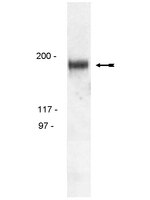Development of vascular endothelial growth factor receptor (VEGFR) kinase inhibitors as anti-angiogenic agents in cancer therapy.
Underiner, T L, et al.
Curr. Med. Chem., 11: 731-45 (2004)
2004
Mostra il sommario
Among the known angiogenic growth factors and cytokines implicated in the modulation of normal and pathological angiogenesis, the VEGF family (VEGF-A, VEGF-B, VEGF-C, VEGF-D) and their corresponding receptor tyrosine kinases [VEGFR-1 (Flt-1), VEGFR-2 (Flk-1, KDR), and VEGFR-3 (Flt-4)] play a paramount and indispensable role in regulating the multiple facets of the angiogenic and lymphangiogenic processes, as well as the induction of vascular permeability and inflammation. The receptor VEGFR-2/KDR is the principal one through which VEGFs exert their mitogenic, chemotactic, and vascular permeabilizing effects on the host vasculature. Increased expression of VEGFs by tumor cells and VEGFR-2/KDR and VEGFR-1/Flt-1 by the tumor-associated vasculature are a hallmark of a variety of human and rodent tumors in vivo and correlates with tumor growth rate, micro-vessel density/proliferation, tumor metastatic potential, and poorer patient prognosis in a variety of malignancies. Approaches to disrupting the VEGF/VEGFR signaling cascade range from biological agents (soluble receptors, anti-VEGF and anti-VEGFR-2 antibodies, and VEGF transcription inhibitors) to small molecule ATP competitive VEGFR inhibitors. Examples from this latter class that are currently in clinical development include compounds from distinct chemical classes such as: indolin-2-ones, anilinoquinazolines, anilinophthalazines, isothiazoles, indolo- and indenocarbazoles. The structure activity relationships, biochemical and pharmacological profile of optimized representatives from each of these classes constitute the subject matter of this review. | 15032727
 |
Vascular endothelial growth factor: basic science and clinical progress.
Ferrara, Napoleone
Endocr. Rev., 25: 581-611 (2004)
2004
Mostra il sommario
Vascular endothelial growth factor (VEGF) is an endothelial cell-specific mitogen in vitro and an angiogenic inducer in a variety of in vivo models. Hypoxia has been shown to be a major inducer of VEGF gene transcription. The tyrosine kinases Flt-1 (VEGFR-1) and Flk-1/KDR (VEGFR-2) are high-affinity VEGF receptors. The role of VEGF in developmental angiogenesis is emphasized by the finding that loss of a single VEGF allele results in defective vascularization and early embryonic lethality. VEGF is critical also for reproductive and bone angiogenesis. Substantial evidence also implicates VEGF as a mediator of pathological angiogenesis. In situ hybridization studies demonstrate expression of VEGF mRNA in the majority of human tumors. Anti-VEGF monoclonal antibodies and other VEGF inhibitors block the growth of several tumor cell lines in nude mice. Clinical trials with various VEGF inhibitors in a variety of malignancies are ongoing. Very recently, an anti-VEGF monoclonal antibody (bevacizumab; Avastin) has been approved by the Food and Drug Administration as a first-line treatment for metastatic colorectal cancer in combination with chemotherapy. Furthermore, VEGF is implicated in intraocular neovascularization associated with diabetic retinopathy and age-related macular degeneration. | 15294883
 |
Receptor chimeras indicate that the vascular endothelial growth factor receptor-1 (VEGFR-1) modulates mitogenic activity of VEGFR-2 in endothelial cells.
Rahimi, N, et al.
J. Biol. Chem., 275: 16986-92 (2000)
1999
Mostra il sommario
Vascular endothelial growth factor (VEGF) provokes angiogenesis in vivo and stimulates growth and differentiation of endothelial cells in vitro. Although VEGF receptor-1 (VEGFR-1) and VEGFR-2 are known to be high affinity receptors for VEGF, it is not clear which of the VEGFRs are responsible for the transmission of the diverse biological responses of VEGF. For this purpose we have constructed a chimeric receptor for VEGFR-1 (CTR) and VEGFR-2 (CKR) in which the extracellular domain of each receptor was replaced with the extracellular domain of human colony-stimulating factor-1 receptor (CSF-1R), and these receptors were expressed in pig aortic endothelial (PAE) cells. We show that CKR individually expressed in PAE cells is readily tyrosine-phosphorylated in vivo, autophosphorylated in vitro, and stimulates cell proliferation in a CSF-1-dependent manner. In contrast, CTR individually expressed in PAE cells showed no significant in vivo, in vitro tyrosine phosphorylation and cell growth in response to CSF-1 stimulation. The kinase activity of CKR was essential for its biological activity, since mutation of lysine 866 to arginine abolished its in vivo, in vitro tyrosine phosphorylation and mitogenic signals. Remarkably, activation of CTR repressed CKR-mediated mitogen-activate protein kinase activation and cell proliferation. Similar effects were observed for VEGFR-2 co-expressed with VEGFR-1. Collectively, these findings demonstrate that VEGFR-2 activation plays a positive role in angiogenesis by promoting endothelial cell proliferation. In contrast, activation of VEGFR-1 plays a stationary role in angiogenesis by antagonizing VEGFR-2 responses. | 10747927
 |










